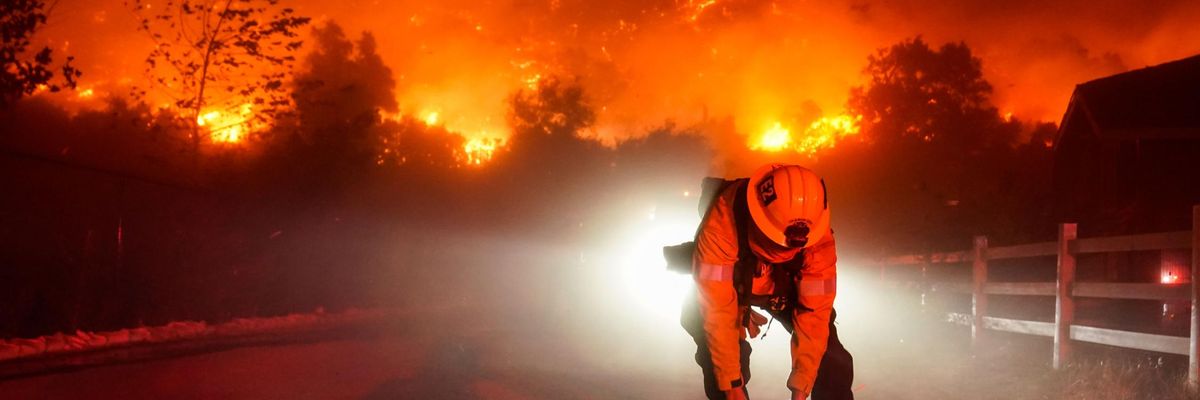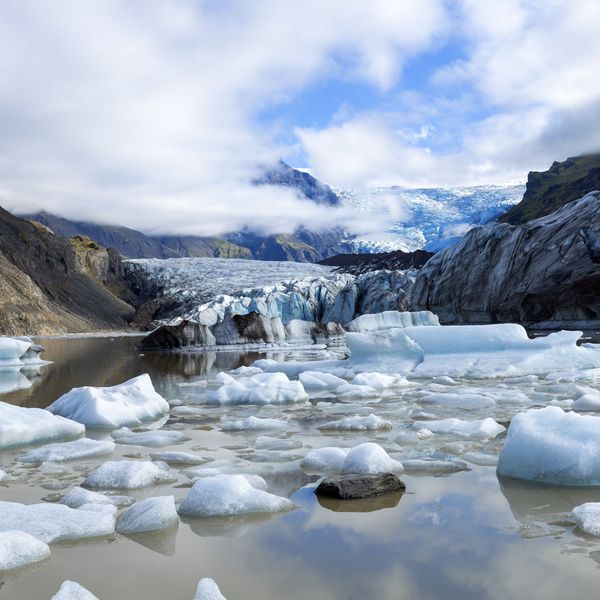
Firefighters battle the Bond Fire, started by a structure fire that extended into nearby vegetation, along Silverado Canyon Road on Thursday, December 3, 2020 in Silverado, California. (Photo: Kent Nishimura/Los Angeles Times via Getty Images)
EPA Data Kept Secret Under Trump Shows Climate Crisis Becoming 'More Evident, Stronger, and Extreme'
"Combating climate change—it's not optional. It's essential," said EPA Administrator Michael Regan.
During its four years in power, the oil-friendly Trump administration kept the Environmental Protection Agency's Climate Change Indicators page completely frozen, suppressing an updated assessment of how the planetary emergency is affecting the United States and other parts of the world.
But on Wednesday, the Biden EPA relaunched the page with new data showing that U.S. cities are experiencing more frequent and intense heat waves, ocean and lake temperatures are climbing, sea levels on U.S. coasts are rising, and wildfire season is peaking earlier.
Those and other alarming trends detailed on the revamped page--which emphasizes that many of the changes "are linked to the rising levels of carbon dioxide and other greenhouse gases in our atmosphere, caused by human activities"--constitute further evidence of the "urgency for action on the climate crisis," EPA Administrator Michael Regan said in a statement.
"With this long overdue update," Regan added, "we now have additional data and a new set of indicators that show climate change has become even more evident, stronger, and extreme--as has the imperative that we take meaningful action."
\u201cYay! The @EPA climate indicators page has finally been updated and refreshed! Although the data itself is... yikes\ud83e\udd74\n\nLots of information to explore and share - check it out at https://t.co/2YvAYj1Lew\u201d— Zack Labe (@Zack Labe) 1620853759
In addition to bringing up to date the page's previously existing categories, the EPA added new sections detailing how rising global temperatures have reduced the surface area of glaciers in Glacier National Park, Montana; shortened the duration of ice cover in the Great Lakes; and lowered permafrost temperatures in Alaska.
"There is no small town, big city, or rural community that is unaffected by the climate crisis," Regan told the New York Times on Wednesday. "Americans are seeing and feeling the impacts up close, with increasing regularity."
\u201cAfter four years of dormancy \u2014 as a part of @POTUS's commitment to scientific quality and transparency \u2014 we have relaunched Climate Change Indicators in the United States. \n\nAs @EPAMichaelRegan said, "Combatting climate change \u2013 it\u2019s not optional. It\u2019s essential." #ClimateChange\u201d— U.S. EPA (@U.S. EPA) 1620845100
As the Washington Post reported Wednesday, the Trump administration "delayed an update to the EPA's peer-reviewed report on climate change indicators, first published in 2010."
"As a result, the report offers a snapshot of the extent to which the science around climate change grew more detailed and robust during [former President Donald] Trump's term, even as his administration at times tried to stifle those findings," the Post noted. "The Trump administration did not take down the climate indicators page, leaving it up with outdated information."
During his White House tenure, Trump repeatedly questioned the findings of government climate scientists, attempted to bury research on the climate emergency's impact, and weakened regulations aimed at reducing planet-warming emissions.
Kristina Dahl, a senior climate scientist with the Union of Concerned Scientists, said that while the Biden administration's decision to revive the EPA assessment is welcome, "it's a bare minimum that this kind of data should be updated regularly and available to the public."
"We have a very long, uphill road ahead of us for actually enacting policies that will make change," Dahl told the Times.
An Urgent Message From Our Co-Founder
Dear Common Dreams reader, The U.S. is on a fast track to authoritarianism like nothing I've ever seen. Meanwhile, corporate news outlets are utterly capitulating to Trump, twisting their coverage to avoid drawing his ire while lining up to stuff cash in his pockets. That's why I believe that Common Dreams is doing the best and most consequential reporting that we've ever done. Our small but mighty team is a progressive reporting powerhouse, covering the news every day that the corporate media never will. Our mission has always been simple: To inform. To inspire. And to ignite change for the common good. Now here's the key piece that I want all our readers to understand: None of this would be possible without your financial support. That's not just some fundraising cliche. It's the absolute and literal truth. We don't accept corporate advertising and never will. We don't have a paywall because we don't think people should be blocked from critical news based on their ability to pay. Everything we do is funded by the donations of readers like you. Will you donate now to help power the nonprofit, independent reporting of Common Dreams? Thank you for being a vital member of our community. Together, we can keep independent journalism alive when it’s needed most. - Craig Brown, Co-founder |
During its four years in power, the oil-friendly Trump administration kept the Environmental Protection Agency's Climate Change Indicators page completely frozen, suppressing an updated assessment of how the planetary emergency is affecting the United States and other parts of the world.
But on Wednesday, the Biden EPA relaunched the page with new data showing that U.S. cities are experiencing more frequent and intense heat waves, ocean and lake temperatures are climbing, sea levels on U.S. coasts are rising, and wildfire season is peaking earlier.
Those and other alarming trends detailed on the revamped page--which emphasizes that many of the changes "are linked to the rising levels of carbon dioxide and other greenhouse gases in our atmosphere, caused by human activities"--constitute further evidence of the "urgency for action on the climate crisis," EPA Administrator Michael Regan said in a statement.
"With this long overdue update," Regan added, "we now have additional data and a new set of indicators that show climate change has become even more evident, stronger, and extreme--as has the imperative that we take meaningful action."
\u201cYay! The @EPA climate indicators page has finally been updated and refreshed! Although the data itself is... yikes\ud83e\udd74\n\nLots of information to explore and share - check it out at https://t.co/2YvAYj1Lew\u201d— Zack Labe (@Zack Labe) 1620853759
In addition to bringing up to date the page's previously existing categories, the EPA added new sections detailing how rising global temperatures have reduced the surface area of glaciers in Glacier National Park, Montana; shortened the duration of ice cover in the Great Lakes; and lowered permafrost temperatures in Alaska.
"There is no small town, big city, or rural community that is unaffected by the climate crisis," Regan told the New York Times on Wednesday. "Americans are seeing and feeling the impacts up close, with increasing regularity."
\u201cAfter four years of dormancy \u2014 as a part of @POTUS's commitment to scientific quality and transparency \u2014 we have relaunched Climate Change Indicators in the United States. \n\nAs @EPAMichaelRegan said, "Combatting climate change \u2013 it\u2019s not optional. It\u2019s essential." #ClimateChange\u201d— U.S. EPA (@U.S. EPA) 1620845100
As the Washington Post reported Wednesday, the Trump administration "delayed an update to the EPA's peer-reviewed report on climate change indicators, first published in 2010."
"As a result, the report offers a snapshot of the extent to which the science around climate change grew more detailed and robust during [former President Donald] Trump's term, even as his administration at times tried to stifle those findings," the Post noted. "The Trump administration did not take down the climate indicators page, leaving it up with outdated information."
During his White House tenure, Trump repeatedly questioned the findings of government climate scientists, attempted to bury research on the climate emergency's impact, and weakened regulations aimed at reducing planet-warming emissions.
Kristina Dahl, a senior climate scientist with the Union of Concerned Scientists, said that while the Biden administration's decision to revive the EPA assessment is welcome, "it's a bare minimum that this kind of data should be updated regularly and available to the public."
"We have a very long, uphill road ahead of us for actually enacting policies that will make change," Dahl told the Times.
During its four years in power, the oil-friendly Trump administration kept the Environmental Protection Agency's Climate Change Indicators page completely frozen, suppressing an updated assessment of how the planetary emergency is affecting the United States and other parts of the world.
But on Wednesday, the Biden EPA relaunched the page with new data showing that U.S. cities are experiencing more frequent and intense heat waves, ocean and lake temperatures are climbing, sea levels on U.S. coasts are rising, and wildfire season is peaking earlier.
Those and other alarming trends detailed on the revamped page--which emphasizes that many of the changes "are linked to the rising levels of carbon dioxide and other greenhouse gases in our atmosphere, caused by human activities"--constitute further evidence of the "urgency for action on the climate crisis," EPA Administrator Michael Regan said in a statement.
"With this long overdue update," Regan added, "we now have additional data and a new set of indicators that show climate change has become even more evident, stronger, and extreme--as has the imperative that we take meaningful action."
\u201cYay! The @EPA climate indicators page has finally been updated and refreshed! Although the data itself is... yikes\ud83e\udd74\n\nLots of information to explore and share - check it out at https://t.co/2YvAYj1Lew\u201d— Zack Labe (@Zack Labe) 1620853759
In addition to bringing up to date the page's previously existing categories, the EPA added new sections detailing how rising global temperatures have reduced the surface area of glaciers in Glacier National Park, Montana; shortened the duration of ice cover in the Great Lakes; and lowered permafrost temperatures in Alaska.
"There is no small town, big city, or rural community that is unaffected by the climate crisis," Regan told the New York Times on Wednesday. "Americans are seeing and feeling the impacts up close, with increasing regularity."
\u201cAfter four years of dormancy \u2014 as a part of @POTUS's commitment to scientific quality and transparency \u2014 we have relaunched Climate Change Indicators in the United States. \n\nAs @EPAMichaelRegan said, "Combatting climate change \u2013 it\u2019s not optional. It\u2019s essential." #ClimateChange\u201d— U.S. EPA (@U.S. EPA) 1620845100
As the Washington Post reported Wednesday, the Trump administration "delayed an update to the EPA's peer-reviewed report on climate change indicators, first published in 2010."
"As a result, the report offers a snapshot of the extent to which the science around climate change grew more detailed and robust during [former President Donald] Trump's term, even as his administration at times tried to stifle those findings," the Post noted. "The Trump administration did not take down the climate indicators page, leaving it up with outdated information."
During his White House tenure, Trump repeatedly questioned the findings of government climate scientists, attempted to bury research on the climate emergency's impact, and weakened regulations aimed at reducing planet-warming emissions.
Kristina Dahl, a senior climate scientist with the Union of Concerned Scientists, said that while the Biden administration's decision to revive the EPA assessment is welcome, "it's a bare minimum that this kind of data should be updated regularly and available to the public."
"We have a very long, uphill road ahead of us for actually enacting policies that will make change," Dahl told the Times.

